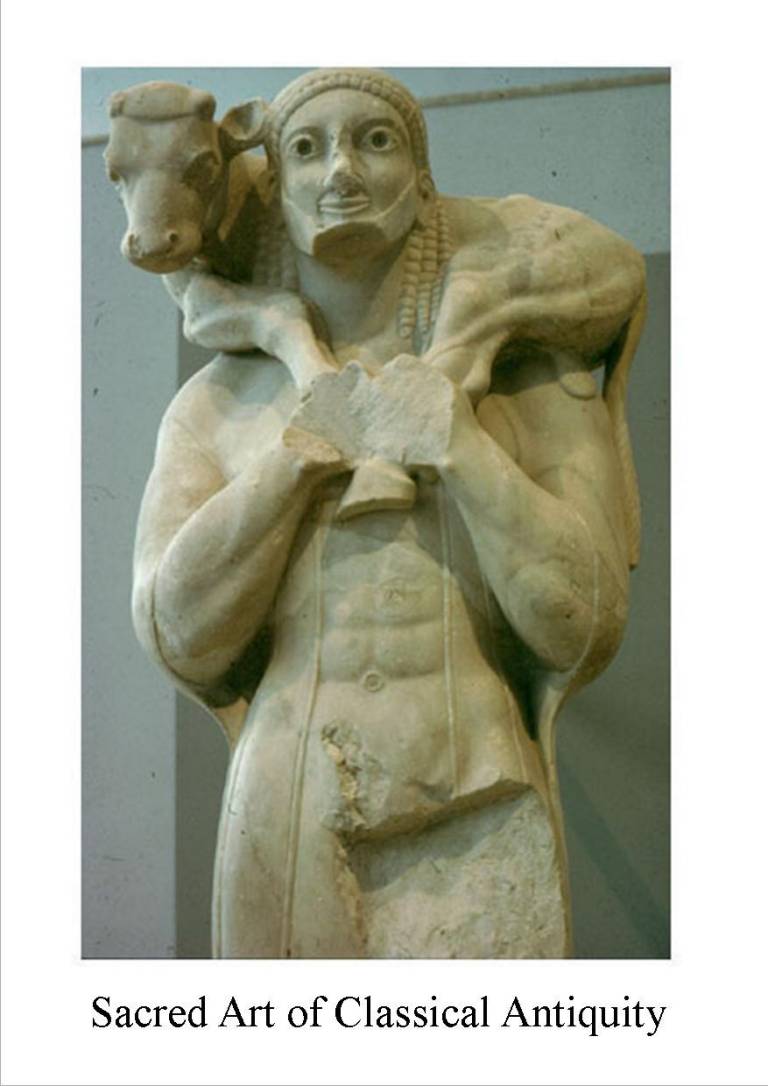SACRED ART OF CLASSICAL ANTIQUITY
Idolatry in Archaic Greece
Using bronze chisels, with huge effort, stone men were carved from the rock, right down to the soles of their feet. Then they were stood in separate stone bases which had footprint depressions to receive them. After the appropriate rites the God was believed to take up residence in the carving, which even the sculptor then worshipped, but the slightest damage (lost finger etc) destroyed the magic; so many near perfect examples are found abandoned. The archaic Greeks lived in mortal fear of hubris- pride would attract the wrath of the gods. There are no portraits at this date. Ideal types only were sculpted; till the Hellenistic period, when the first likenesses appear.
Ancient stone sculpture was painted with bright colours. When improvements in bronze casting freed the pose of the figure, contrasting metals and other additions were used to give colour to the bronze too. Newly finished bronzes were pink, like sunburnt bodies. The idea that stone sculpture must be monochrome, and bronzes should have empty eyes, is a neoclassical mistake.
How was the Parthenon used for worship? Only the priestesses of Athena went inside. The public gathered round the exterior, unlike a modern church. Among the Gods of Olympus, Dionysus was the relative newcomer. The technique of making wine from grapes seems to have entered Greece from the East about the seventh century BC, and the worship of the wine god with it. Encouraged by his mother, Alexander the Great believed himself to be the son of Zeus-he claimed to be the son of God and therefore believed himself divine- perhaps an incarnation of Dionysos? ( He certainly drank enough wine for this to be credible). After all, the night he was born, the temple of Diana at Ephesus burned to the ground. Surely this must be a divine portent? Unlike any other mortal man, Alexander was admitted to the Parthenon- he was seen as a relative. When he died, his generals took over parts of his empire and glorified themselves- as Alexander had done. The Romans emerged late in the Hellenistic period. They are inevitably influenced by things Greek (things which they did not always fully understand). However they did not share the ancient Greeks’ fear of hubris. When his subjects in the Eastern empire offered to worship Augustus as divine, he laughed and said,“ If I were a god I could work miracles; and as you can see, I cannot”. All the same, the Senate voted Caesar this new honour, which then became for every subject a test of loyalty. Pliny’s letter to Trajan“De Christianis” shows him using enforced worship of the statue of Caesar as the litmus test for secret Christians. Despite his show of Republican modesty, Augustus had put himself at the head of both state and religion. However his dynasty ended disastrously. In the second century AD Hadrian led a renaissance of Roman art, based on his limitless admiration for the achievements of the Greeks. Intelligent, creative and far- sighted, Hadrian sought to set limits to the empire instead of the endless conquest of his predecessor Trajan. Unfinished monuments of others he completed, often at his own expense, - sometimes acting anonymously (e.g. Pantheon) Yet when we unravel the story of the Temple of Venus at Corinth, it is not hard to see why St Paul and the early Corinthian Christians could have nothing to do with the gods. He writes- “You boast of things of which you should be ashamed”
